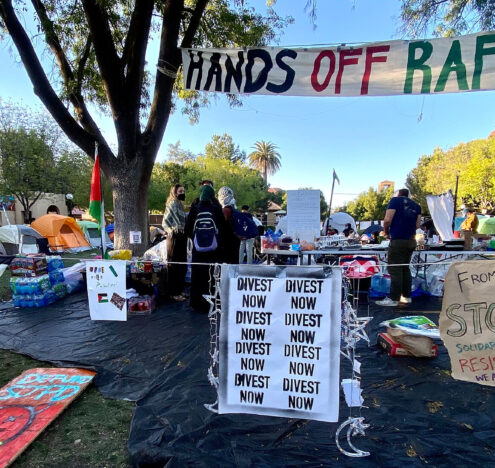“Adults in a Room” is a series in collaboration with The Stimson Center’s Reimagining US Grand Strategy program. The series stems from the group’s monthly networking events that call on analysts to gather virtually and hash out a salient topic. It aims to give you a peek into their Zoom room and a deep understanding of the issue at hand in less than the time it takes to sip your morning coffee without the jargon, acronyms, and stuffiness that often come with expertise.
North Korea has proven to be a persistent challenge for US administrations over the past two decades, steadily developing its nuclear program in the face of US efforts to curtail it. At the same time, the relationship between the United States and South Korea has continued to grow.
The economic, cultural, and military relationships between the United States and South Korea were celebrated in April 2023 with a state dinner for South Korean President Yoon Suk-yeol at the White House, but the topic of North Korea remained central to the visit. The Biden administration faces a test in how it balances its important relationship with South Korea, the threat posed by North Korea’s now-established nuclear program, and the US desire to focus its East Asia policy on addressing China’s growing geopolitical influence.
The Reimagining US Grand Strategy’s May 2023 roundtable focused on the question of what the Biden administration’s policy toward the Korean peninsula appears to be and whether that approach is likely to yield success. Three participants shared their views. In the meantime, the USS Michigan, one of the largest submarines in the world, docked in Busan, South Korea in June. And last week, the USS Kentucky, a US ballistic missile submarine or SSBN arrived at the same port, followed by the USS Annapolis (powdered by a nuclear reactor but equipped with conventional weapons) that docked this morning.
Jenny Town, Senior Fellow and Director, 38 North
Yoon’s state visit in April 2023 marked the 70-year anniversary of the US-ROK alliance with great fanfare, emphasizing the growth and expansion of that cooperation into a “global comprehensive strategic alliance.”
One of the achievements of this second summit between President Joe Biden and Yoon was the announcement of the Washington Declaration, which opens the door to a new level of bilateral consultation and cooperation on nuclear weapons policy, planning, and conventional support of nuclear operations. The declaration announced the establishment of a bilateral Nuclear Consultative Group, a mechanism to facilitate greater information sharing and dialogue on nuclear and strategic planning. This was a significant measure to enhance trust and understanding of US nuclear decision-making, should the use of nuclear weapons on the Korean Peninsula ever have to be considered.
Being better prepared for potential conflict on the Korean Peninsula is important, but what is being done to reduce threats and lower tensions in the region?
However, the Washington Declaration is just the latest of several efforts in recent years to bolster US extended deterrence and address a growing assurance challenge in South Korea amid rapidly advancing North Korean weapons of mass destruction capabilities and an increasingly dangerous geopolitical landscape. The announcement was also framed as a way to quiet the debate in South Korea about its own nuclear future spurred by growing domestic support for a South Korean nuclear deterrent and comments by Yoon earlier this year that seemed to put the nuclear option on the table.
In many ways, the Washington Declaration demonstrates the nature of the problem at hand. While these measures advance alliance cooperation in the military realm, they address only one side of the equation. Being better prepared for potential conflict on the Korean Peninsula is important, but what is being done to reduce threats and lower tensions in the region?
The Biden administration appears to have a negotiation strategy, should North Korea ever be willing to talk about its nuclear program again. But the prospects of Pyongyang voluntarily making that choice in the near term are bleak. The high-profile failure to secure a breakthrough agreement in 2019 has left scars in the relationship that was already filled with deep mistrust on both sides. Moreover, increased US-China rivalry is fueling an arms race in northeast Asia, and the growing emphasis on ideological blocs is creating a scenario in which insecurity is rising, solidarity is growing within these blocs, and the prospects for cooperation across them seem less and less likely.
In this kind of environment, rebuilding diplomacy with North Korea is no doubt a difficult task, but given the stakes is necessary to reduce the risk of nuclear conflict on the peninsula. This will take more deliberate efforts than simply offering unconditional talks about denuclearization. Finding issues of common security, making more specific proposals to manage expectations, and demonstrating that results are possible in order to rebuild confidence that there is a reason for Pyongyang to re-engage in diplomacy with the United States on any topic are all important goals to consider.
The stakes are high as North Korea hones its intercontinental ballistic missile capabilities and South Korea contemplates its own nuclear future. As much as efforts are being made to try to create diplomatic openings and restore channels of communication between the United States and China, similar and perhaps parallel efforts are needed for North Korea as well to try to move perilous trends in regional security dynamics in a more positive and productive direction.
Jennifer Lind, Associate Professor of Government, Dartmouth University
North Korea’s advances in its nuclear program — particularly its development of intercontinental ballistic missiles — have created uncertainty about the US nuclear umbrella. War on the peninsula would create serious escalation risks. Previously, the United States promised to retaliate against a North Korean nuclear strike on the south with the knowledge that Pyongyang could not then strike the United States. But increasingly, North Korea’s intercontinental reach would enable it to retaliate against US cities.
If the Washington Declaration fails to reassure South Korea, the NATO experience highlights a set of possible options for South Korea and the United States today.
This weakens the deterrent threat vis-à-vis North Korea and reduces US credibility in the eyes of South Koreans. They understand that any rational US leader would hesitate to give an order that could lead to the deaths of millions of Americans — the greatest foreign policy catastrophe in US history. Thus South Koreans are increasingly discussing acquiring an independent nuclear arsenal.
At their summit in Washington DC in April 2023, the Biden and Yoon governments issued the Washington Declaration in which they affirmed that the United States would retaliate against a North Korean nuclear attack against the ROK. The declaration also committed to joint wargaming and created a Nuclear Consultative Group. Biden also announced port visits by US nuclear submarines to South Korean ports and pledged to consult with Seoul regarding any nuclear weapons use on the peninsula. In turn, Yoon reaffirmed South Korea’s obligations to the Nuclear Non-Proliferation Treaty. Although these are all thoughtful policies, they do not address the fundamental issue of US willingness to risk a nuclear attack on the United States.
A deterrence crisis in NATO in the 1960s is revealing. The Soviet Union’s development of intercontinental nuclear capabilities touched off a crisis in NATO about US credibility. US leaders were unable to mollify allied fears with gestures akin to those in the Washington Declaration. The allies solved the problem through the United States stationing its nuclear weapons at allied bases, and through a nuclear sharing program. Belgium, Italy, Netherlands, and West Germany all accepted this solution. France, however, chose to develop an independent nuclear arsenal. If the Washington Declaration fails to reassure South Korea, the NATO experience highlights a set of possible options for South Korea and the United States today.
Robert Manning, Distinguished Senior Fellow, Stimson Center’s Reimagining US Grand Strategy Program
There are some wicked problems that defy solutions and can only be managed. North Korea is at the top of the list. After three decades of failed diplomacy, North Korea’s breakneck effort to develop a full spectrum of modern ballistic missiles and nuclear weapons — intercontinental ballistic missiles that can reach the continental United States, tactical nuclear weapons, and nuclear-capable submarines — has changed the strategic equation.
To date, its leader, Kim Jong Un, has made it clear that he has no interest in talking to either the United States or South Korea. While the United States’ aspiration remains a denuclearized North Korea, it is difficult to envision a circumstance under which Pyongyang would verifiably give up its nuclear weapons so long as the Kim dynasty is in power.
While the United States retains the aspiration of denuclearization and a UN sanctions regime denies legitimacy to Pyongyang’s nuclear status, the de facto reality is that interim steps may be the least bad option.
This reflects three decades of failed diplomacy. The 2005 Agreed Statement, the result of the China-hosted Six-Party talks that includes the United States, South Korea, North Korea, China, Russia, and Japan, offered a comprehensive solution but unraveled as Pyongyang refused the necessary transparency for verification. Previous efforts, such as the 1994 Agreed Framework, also collapsed for the same reason. The most recent effort, the Trump-Kim summit, failed when then President Donald Trump rejected Kim’s offer and walked out of a meeting in Hanoi rather than put a counter-offer on the table.
Kim appears to have been shocked and angry by Trump’s exit. Since then, Pyongyang’s views have hardened. But Kim drew conclusions from the fate of Iraq, absent nukes, and of Libya and Ukraine abandoning them. Nuclear weapons have become essential to the identity of the Pyongyang regime, embodied in its constitution. North Korea has a vested bureaucratic interest in its nuclear endeavor. For Kim, it is an easy choice: trust US assurances or nuclear weapons.
Given this predicament, the Biden administration, while repeatedly offering unconditional meetings, has focused on strengthening extended deterrence in this new security environment. US-ROK-Japan security trilateral intelligence and security cooperation has deepened. While the United States retains the aspiration of denuclearization and a UN sanctions regime denies legitimacy to Pyongyang’s nuclear status, the de facto reality is that interim steps may be the least bad option.
The idea of a cap-and-freeze in Pyongyang’s missile and nuclear weapons programs is occasionally floated by outside analysts. Yet, such an arms control accord would likely be an end state even though it is presented as an interim step. Kim would have to signal interest in such an idea, and the United States would have to weigh the price, legitimizing North Korea as a nuclear state, undermining the nonproliferation regime, and likely sanctions relief. US politics and Pyongyang’s resistance to necessary International Atomic Energy Agency monitoring and verification would make such an accord problematic but worth exploring.





















